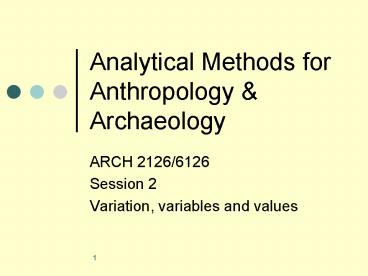Analytical Methods for Anthropology PowerPoint PPT Presentation
1 / 16
Title: Analytical Methods for Anthropology
1
Analytical Methods for Anthropology Archaeology
- ARCH 2126/6126
- Session 2
- Variation, variables and values
2
The purpose of statistics
- To provide insight into situations and problems
by means of numbers - How is this provided?
- Numerical data are available or are collected
- Data are organized, summarized, analysed and
results presented - Conclusions are drawn, in context
- Whole process is often guided by critical
appraisal of similar work already done
3
M. R. Dawkins
- Statistical description is the quest for
patterns or rules which permit reduction in the
quantity of data without undue loss of
information. Some reduction is essential if the
description is to be useful. One cannot publish
ones field notebook. Clearly some data must be
thrown away. (1974)
4
Whether categorical or metrical, the essence is
variation
- Almost always empirical research describes
attributes of a society or culture, a site or
artefact, an individual or population, which vary
(or might vary) this is intrinsic to our
interest - Single entities may vary within a set sets of
entities may differ on average - How to capture this variation?
5
Characterizing variation
- Where variation is described in words or images,
analysis may be likewise verbal or visual, and
relatively informal - But even where entities are simply categorized,
they can be counted - And where they are measured, the methods
available for summarizing variation are
inherently quantitative
6
Data, variables and values
- What are data? (Singular datum Plural data)
- Givens fixed points which constrain possible
interpretations - Variation can be more formally seen in terms of
variables e.g. stature - In a particular case, the variable attains a
particular value, e.g. stature of a particular
person may be 178 cm
7
Kinds of variables
- Variables that can be analysed numerically are of
several different sorts - Categorical/qualitative/nominal variables
- Ranked/ordered/ordinal variables
- Numerical/quantitative/metric variables
- Different kinds of variables allow different
kinds of numerical analysis - This applies to the method of description or
measurement, not the basic property
8
Categorical/qualitative/nominal
- E.g. female/male, A/B/AB/O blood groups, marital
or employment status, artefact types - You can assign code numbers to these values if it
helps you to do so e.g. in SPSS you might code
female as 1, male as 2, missing data as 9 - But in that case it is arbitrary what numbers you
assign, you could have assigned reversed or
different ones, and there is no implication of a
mathematical relationship between the values - You might summarize by reporting the modal (most
common) category there is no average - All cases should normally be placed in one and
only one category
9
Ranked/ordered/ordinal
- Any numbers assigned indicate an ordered
relationship between the values, but not
necessarily any more than that - E.g. many sociological psychological
questionnaires have an ordered range of answers
primatologists infer dominance amongst monkeys
these can be coded the codes indicate relative
rank only - Results can be reported as modes or as medians
(middle values of a distribution)
10
Numerical/quantitative/metric
- The case most familiar to scientists, where
numbers have a true mathematical meaning the
variable varies along an ordered scale of equal
units 3 is as far from 4 as 4 is from 5 - E.g. the weight of a person, the length of a
stone artefact, the volume of a pottery vessel,
the area of a village - It is meaningful to calculate a mean (average) as
well as a median or mode
11
Numerical variables may have either interval or
ratio scales
- Both have an ordered scale of equal units
- Interval scales have equal units but do not make
multiplicative sense or have a mathematically
meaningful zero, e.g. ºC - Ratio scales make multiplicative sense, e.g. a 66
kg person is twice as heavy as a 33 kg person
and zero is meaningful - We shall generally not need to distinguish
between interval and ratio subtypes of numerical
variables
12
Numerical variables may be continuous or
discontinuous
- Continuous variables are in principle infinite
and values may fall anywhere along the scale,
between as well as on integers e.g. weights,
volumes, areas, angles, linear measurements - Discontinuous variables are essentially counts
can only be integers e.g. no. of household
members, fingerprint ridge counts, no. of teeth
in a mandible or artefacts in a spit - Means can be calculated for either
13
More terminology about variables
- Frequency of any value of a variable is the
number of times that value is found i.e. it is a
count, an absolute number - Relative frequency of any value is its frequency,
expressed as a proportion of all observations
(often a percent)
14
More terminology about variables
- Ratio the size of a number relative to another
number - Proportion a ratio in which the second number
includes the first - Percentage a proportion multiplied by 100
- Rate a ratio of the number of events to the
number of cases at risk of experiencing that event
15
Data sets
- Usually data do not come singly they come in,
or are collected in, sets - We collect them because we want to test some idea
against them - E.g. we might want to test whether the stone
artefacts from one site differ in size from stone
artefacts from another - For this, we measure artefact sizes
systematically consistently
16
Examples of presentation
- Even the simplest forms of stating findings
percentages, averages and the simplest
graphical presentations emphasize selected
aspects - This can be legitimate can also be misleading
much depends on honesty clarity with which
procedure is described - What as a percentage of what?
- Does the graph have linear scales? A zero?
- Please bring in examples yourselves

